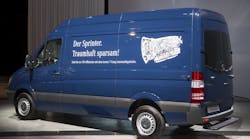Stuttgart, Germany. Daimler AG underscored the company’s commitment to technology, efficiency and sustainability at an exclusive IAA preview event held here in Stuttgart last week. Members of the press from around the world gathered to see and learn about new commercial vehicle products for the global market.
The future is all about globalization, technological leadership, efficiency, sustainability, quality and aggressive growth, explained Andreas Renschler, member of the Daimler AG Board of Management with responsibility for Daimler trucks and Daimler buses.
Vehicles displayed included a new heavy-duty delivery truck called the Mercedes-Benz Antos, a new Mercedes-Benz city van called the Citan, new transit and tour buses from Mercedes-Benz and Setra and new environmentally friendly vehicles, including the Mercedes-Benz all-electric, Vito E-Cell crewbus and the new Fuso Canter Eco Hybrid. A Sprinter van equipped with a seven-speed, automatic transmission and enhanced ESP functions also shared the event spotlight.
The Sprinter has become well-known in the U.S. The June 2012 YTD Market Share for Sprinter in the U.S. is 7.0%, up from 6.3% YTD in June 2011. Sprinter’s market share has doubled since the company reorganized the distribution network under Mercedes-Benz and Freightliner in 2010.
While most of the new vehicles shown in Stuttgart are not headed for American shores-- at least not immediately-- the vision, philosophy and technologies underpinning all the new product introductions were, in many ways, at least as important as their immediate expressions in the specific new chassis on display. They will impact every market, including North America.
Daimler’s commitment to the development of global platforms, including implementation of a modular strategy for all powertrain components, is a good example. The company has a new operating unit called Global Powertrain…. In his presentation about the “module strategy for all powertrain components,” Stefan Buchner, head of the powertrain division, said that common engines, transmissions, axles and exhaust aftertreatment systems are or will be shared across all brands around the world, including Mercedes, Freightliner and Western Star. This strategy is the key lever to realizing our economies of scale, he noted. “We have a modified and ambitious strategy in place to leverage and push our position as [the] worldwide, leading powertrain manufacturer.”
Both Buchner and Renschler cited the company’s heavy-duty engine business as an example of the benefits to be gained from developing common platforms for the global marketplace. “Our company’s growth in new markets and segments helps us to better utilize the potential of our global platforms,” noted Renschler. “As I’ve mentioned, a great example of this is the new generation of our heavy-duty engines. Around 80 percent of the parts for these engines [are] now shared worldwide. And if you consider that the powertrain makes up more than half of a truck’s cost, you can understand why this enables us to achieve great economies of scale.”
He also observed that this global parts sharing strategy “not only improves our cost structure and flexibility, but also boosts the customer utility and quality of our products.”
Efficiency and sustainability were also central issues during the IAA preview, concerns that resonate equally on both sides of the Atlantic. “The importance of a vehicle’s total cost of ownership is growing worldwide,” noted Renschler, “not only in regards to trucks, but also to buses and vans….about 90 percent of a truck’s cost are generated after its purchase.
“Fuel costs are particularly important, and their significance is further increasing…,” he added. “All-in-all, the costs for diesel are three times the price of the truck itself. In line with this development, our trucks and buses consume less fuel despite using Euro VI technology. And that is quite an achievement…"
We are also showing what efficiency means outside of Europe with models such as the Freightliner Cascadia [in the U.S.] and the Fuso Canter Eco Hybrid [in Asia], Renschler added. The complete vehicle portfolio of Daimler Trucks North America has been certified in line with the tough GHG 14 standard for the reduction of greenhouse gas emissions, a whole year before it becomes mandatory.
On the show floor, the new Vito E-Cell crewbus, which can carry up to seven passengers, underscored the strengthening link between efficiency and sustainability. The all-electric vehicle displayed uses no fossil fuel during its operation and has no exhaust emissions. It will be offered initially in 16 countries throughout Europe, but its zero-emissions profile could make it of potential interest in US cities as well, especially in non-attainment areas.
The new light-duty Fuso Canter Eco Hybrid is another green offering that turned heads at the IAA preview. According to Daimler, the hybrid consumes 23 percent less fuel than its diesel counterpart. It will go into production for the European market later this fall. “Fuso’s new Canter Eco Hybrid is the world’s first hybrid truck in which [this] expensive technology actually pays off,” observed Renschler.
Interestingly, no natural gas powered trucks were exhibited at the IAA preview as examples of fuel conservation and emissions reduction. They were not included in the line-up of new offerings, the company noted, because the technology is not “new” anymore.
Daimler did not give away everything in its extensive preview of IAA attractions, however. There are “plenty of surprises” still ahead for this fall, noted several speakers. One hint: trailers. “A crucial factor in achieving benchmark results in terms of fuel efficiency is improved aerodynamics,” observed Renschler. “…. And we will demonstrate that even greater benefits can be produced using an optimal trailer. You can certainly expect some surprises here.”
When it comes to predicting the strength of the global commercial truck market, forecasts were generally positive, if not surprising. The global truck market should increase by an average of 3.6 percent per year, Renschler told the audience, which is much faster than in the past decade. So despite all the market oscillations, the commercial vehicle business will remain a growth business.
“Russia, India and China, in particular, will see a rapid rise in sales, and these countries are also experiencing a clear trend toward higher quality vehicles…” he noted. “Nonetheless, the lion’s share of the profits will continue to be generated in Europe, North American and Japan.”
For Daimler Trucks, the company expects sales to rise to half a million units in 2013 and to reach 700,000 units by 2020.
IAA, the world’s largest commercial vehicle exhibition, will be held in Hanover, Germany this year from September 20-27.



